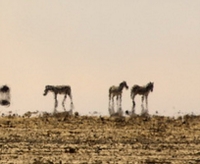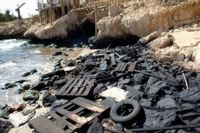 April 07
April 07
Hot Times in the Holy Land: The Effects of Global Climate Change on Israel
Professor Alon Tal
 Ten thousand years ago, hippopotami roamed a much more humid Sahara region in Africa that was filled with lakes and vegetation. Similarly, Israel’s climate of the not-so-distant past bore little resemblance to present conditions. More rain fell across much of the country and temperatures were substantially more moderate. These climatic changes, encompassing Africa, Israel, and the entire globe, happened gradually and over long periods of time. In contrast, the wave of climatic changes resulting from global warming is anticipated to occur at a much faster pace – over the course of a few generations instead of many millennia. In the past people and ecosystems had ample time to adapt to these changes. Now they may not.
Ten thousand years ago, hippopotami roamed a much more humid Sahara region in Africa that was filled with lakes and vegetation. Similarly, Israel’s climate of the not-so-distant past bore little resemblance to present conditions. More rain fell across much of the country and temperatures were substantially more moderate. These climatic changes, encompassing Africa, Israel, and the entire globe, happened gradually and over long periods of time. In contrast, the wave of climatic changes resulting from global warming is anticipated to occur at a much faster pace – over the course of a few generations instead of many millennia. In the past people and ecosystems had ample time to adapt to these changes. Now they may not.
What impacts will this rapid change have on Israel? The scientific community generally agrees that climate change will produce “winners” and “losers.” In some parts of the world, global warming may actually improve agricultural productivity. In others, severe storms, excessive drought, and thawing ice related to global climate change could (and already does) devastate local ecologies and communities. Weather is becoming more extreme – that much is clear even without empirical data. While the dust has not yet settled, the overall signs for Israel are not encouraging.
The Worst Case Scenario - and the Worse than Worst
In 2000, Israel submitted a long-awaited report under the UN Convention for Climate Change . The report offered a dispiriting summary of global warming’s likely environmental impacts on the country. The worst case scenarios contained the following effects:
An increase in average temperatures of 1.6° to 1.8°;
A drop of 4 to 8 percent drop in overall precipitation;
A 10% increase in evapotranspiration (which means plants will need to receive more water to grow at present rates);
Increased rain intensity and a shortened rainy season;
Greater seasonable variability in the temperatures;
Increased frequency and severity of extreme climate events;
A rise in the sea level rise of 12-88cm;
An increase in atmospheric concentrations of CO2 reaching 560ppmv by the year 2040-2065.
This laundry list of numeric statistics, however, does not fully characterize the impact that global warming will have on Israel’s climate, even in a non-worst-case scenario. In particular, the likely effects of even a moderate rise in global temperatures will include:
Drop in Precipitation/Ecosystem Disturbance. Israel’s physical and climatic conditions vary dramatically across a landscape that is the geographical equivalent of a postage stamp. A wide-ranging rain gradient runs from the arid desert south – where rainfall can be as little as 20 mm/year – to the humid northern Galilee. While the resolution of existing scientific climate models is far from perfect and modelers attempting to predict climate change continue to hold a variety of opinions, there is a general consensus that the line differentiating the more rainy and more fertile regions may be inching north. Geologist Hanan Ginat of the Arava Institute for Environmental Studies has collected data showing a 50% drop in annual precipitation in the Arava desert and around the Dead Sea during the past forty years. Meanwhile, evaporation rates have increased in the south by as much as 19%. Ginat’s results are still preliminary, but the general trend is clear: If rainfall continues to shift northward, the plants and animals on the edges of these different ecosystems will face significant climatic transformation. In some areas where there are still open spaces, some may migrate with the changing habitat and adapt to new conditions; but many may not.
Agricultural Devastation. Israel’s beleaguered agricultural sector may be the primary loser in the country’s shifting climatic reality. Changes in government support, increases in water prices, and relentless competition from North Africa have already created precarious profit margins for the country’s farmers. As mentioned above, one of global warming’s key impacts is a decline in precipitation, equaling a shortened rainy growing season. Many farmers who in the past enjoyed modest rainfall in “semi-arid” zones might soon have to revert to fully irrigated regimes. In an ironic postscript to David Ben-Gurion’s original vision to “make the desert bloom,” this shift will reduce certain crops and yields and squeeze out independent family farms that cannot afford increased demand on capital.
Increased Floods. Many of global warming’s effects on Israel’s residents and economy are already apparent. Tel Aviv suffers from what was once termed “hundred-year floods” with a regularity that makes one wonder whether this estimate needs to be recalibrated. Images of families escaping through upper windows in low lying houses and kayaking across the Ayalon highway used to capture the attention of television news broadcasts. Now they are increasingly commonplace. Bear in mind that these floods are not due to rising sea levels, which some have suggested can be ameliorated with Netherlands-style dikes and seawalls, but to changes in Israel's precipitation and climactic patterns, which cannot be ameliorated with the same scale of engineering.
Very Hot Summers. A new longitudinal study commissioned by the Ministry of Environmental Protection reports that maximum summer temperatures have increased by one degree in recent years. The chance of a day in summer being “very hot” as opposed to “moderately hot” has increased by 300% during the past forty years. Residents and August visitors to Israel do not need empirical evidence to confirm these rising temperatures. Even Jerusalem – situated high in the Judean hills and traditionally a venue for cool summer evenings – now consistently has days when temperatures exceed 35 degrees Celsius (95 degrees Fahrenheit).
 Beach Erosion/Cost to Tourism. The country’s beaches along the Mediterranean are expected to suffer greater erosion due to the increased frequency of extreme weather events and the anticipated growth in the impact of the ocean’s waves. This means that the key open space resource for Israel’s urban population, the beach, will dwindle, even without the parallel phenomenon of urban development sprawl. Additionally, if waves continue to rise, the roads running the length of the Gulf of Eilat could become fully submerged. Rough initial estimates of damage from the rise in sea level are as high as $1.6 billion in infrastructure loss. The indirect costs, such as the loss of tourism in the Mediterranean, could be many times higher.
Beach Erosion/Cost to Tourism. The country’s beaches along the Mediterranean are expected to suffer greater erosion due to the increased frequency of extreme weather events and the anticipated growth in the impact of the ocean’s waves. This means that the key open space resource for Israel’s urban population, the beach, will dwindle, even without the parallel phenomenon of urban development sprawl. Additionally, if waves continue to rise, the roads running the length of the Gulf of Eilat could become fully submerged. Rough initial estimates of damage from the rise in sea level are as high as $1.6 billion in infrastructure loss. The indirect costs, such as the loss of tourism in the Mediterranean, could be many times higher.
Israel’s Response to Climate Change
Israel was quick to sign on the United Nations Framework Convention on Climate Change in 1992 when the international treaty for global warming made its first appearance. This alacrity was related to the country receiving a curious classification as a “developing nation.” Under the UN framework, economically developed nations that have signed the treaty – known as Annex I countries –are required to reduce greenhouse gas (GHG) emissions to below or equal to 1990 levels. This obligation can involve a highly disruptive systemic reconfiguration of the country’s heating, transportation, and manufacturing policies. In contrast, developing countries are expected to do little more than take inventories of emissions and receive economic credit for projects that reduce global warming emissions.
Several somewhat anomalous reasons are typically suggested as to why Israel, whose economy is stronger than many of the Annex I nations, enjoys this “developing nation” status. One argument is that the massive influx of immigrants from the former Soviet Union during the late 1980s and early 1990s gave Israel the population profile of a developing country. Others point to the inevitability of desalination as a solution to the region’s water scarcity crisis. Desalination requires energy intensive technology, making draconian GHG ceilings unrealistic. More generally, tolerance of Israel’s special “developing nation” status is balanced by hopes of relieving some of the pressure of the Arab-Israeli conflicts around water scarcity.
Despite this status, the Israeli government waited four years – until 1996 – to actually ratify the treaty, and it was only a decade later that Israel legally approved its Kyoto Protocol with its emissions target and trading system. As a result, the country’s economic and energy policies fly in the face of growing international concerns about greenhouse gas emissions. Israel’s Ministry of Environmental Protection reports that Israel’s emissions now exceed 80 million tons of carbon dioxide equivalents per year, most of which comes from the energy and transportation sectors. National energy demands are increasing by 4% a year, which is twice the rate of population growth, and will likely double in less than twenty years.
Obviously, many in Israel and abroad argue that the small state has more pressing concerns than climate change, notwithstanding the potentially devastating economic and environmental effects summarized above. And in all fairness, the Israeli government and some businesses have taken a variety of small steps towards promoting clean energy. In some plants, there has been a steady shift away from coal and heavy fuels towards natural gas in power plants. This shift will both improve ambient air pollution and reduce greenhouse gas emissions. In one of his first acts as Prime Minister, Ehud Olmert embraced a plan to create Israel’s first solar power plant in the Negev desert. Additionally, a Bedouin village, Dajaret, has installed a solar power facility. However, the effects of climate change on Israel are quite severe, as are the costs of continued reliance on fossil fuels; Israel still imports most of its oil and energy constitutes a significant outlay of foreign currency in its balance of trade.








